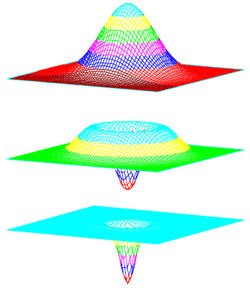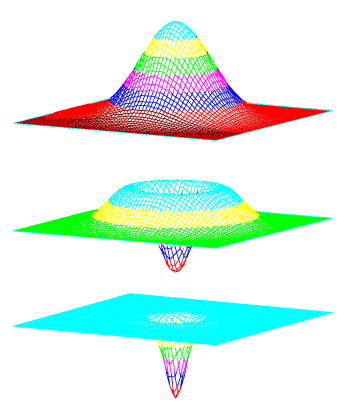Journey to the Center of the Neutron
A neutron contains three quarks, and nuclear physicists don’t completely understand how these move within the particle. Last year, an analysis revealed a negative charge at the center of the neutron, and now an article in the Rapid Communications section of the September Physical Review C attributes this negative core to very fast moving “down” quarks. The results elaborate on an emerging three-dimensional view of these fundamental particles and their proton cousins.
The neutron consists of an up quark with a charge of +2/3 and two down quarks, each with a charge of -1/3. These quarks are continually moving around in random directions and at random speeds, but there are patterns. The most definitive understanding of neutron structure comes from scattering experiments, where an electron beam hits a gas or liquid target that is naturally full of neutrons. The quarks move so fast inside each neutron–close to the speed of light–that according to relativity theory, space and time look different to each of the quarks, which renders some scattering results ambiguous. To get around this problem, nuclear physicists often describe the neutron as it would appear when approaching at the speed of light–an infinitely-thin disk. This viewpoint has been used for decades by researchers who study inelastic scattering, which measures the quarks’ momenta by blasting quarks entirely out of the neutron.
But last year Gerald A. Miller of the University of Washington in Seattle applied this viewpoint to elastic scattering experiments, which leave the neutron intact. Instead of measuring the quarks’ momenta, these experiments reveal the positions of charges within the neutron. For decades, such experiments have implied that the neutron is a negatively-charged cloud surrounding a positive central region. But Miller’s re-analysis showed that a negative charge also exists at the core of the neutron, inside the positive region [1]. “It was a big surprise to all of us,” says Carl Carlson of the College of William and Mary in Williamsburg, Virginia.
Meanwhile, the higher-energy, inelastic experiments that measure quark momentum have found for years that the occasional quark with much more momentum than usual is much more likely to be a negative, down quark than a positive, up quark. Now Miller and John Arrington of Argonne National Laboratory in Illinois have shown that these fast-moving, mostly negatively-charged quarks are more likely to be near the neutron’s center. So the negatively-charged core is a result of the fastest quarks appearing there, according to their new work.
Miller and Arrington’s analysis combines two traditionally separate areas of nuclear research. “Historically, the momentum and spatial analysis was done independently,” says Arrington. They found that when looking at the spatial charge distribution for the highest-momentum quarks, the center of the neutron–not relevant in momentum analyses–was a concept that needed careful attention. It turned out that when a single quark carries most of the energy and momentum of the neutron, it is automatically near the center. It’s a bit like the earth-moon system–the two bodies orbit each other, but the earth’s dominant mass puts it very near the center of their mutual orbit.
By combining the information from different experiments, “we’re getting a more comprehensive, three-dimensional picture of the nucleons,” says Matthias Burkardt of New Mexico State University in Las Cruces. He says this picture may help theorists better understand how QCD–the accepted theory of quark interactions that is famously difficult to use in calculations–plays out in simple particles.
–Don Monroe
Don Monroe is a freelance science writer in Murray Hill, New Jersey.
References
- G. A. Miller, “Charge Densities of the Neutron and Proton,” Phys. Rev. Lett. 99, 112001 (2007)
More Information
2003 Focus story describing a new way to analyze quark motion that was used in this paper





